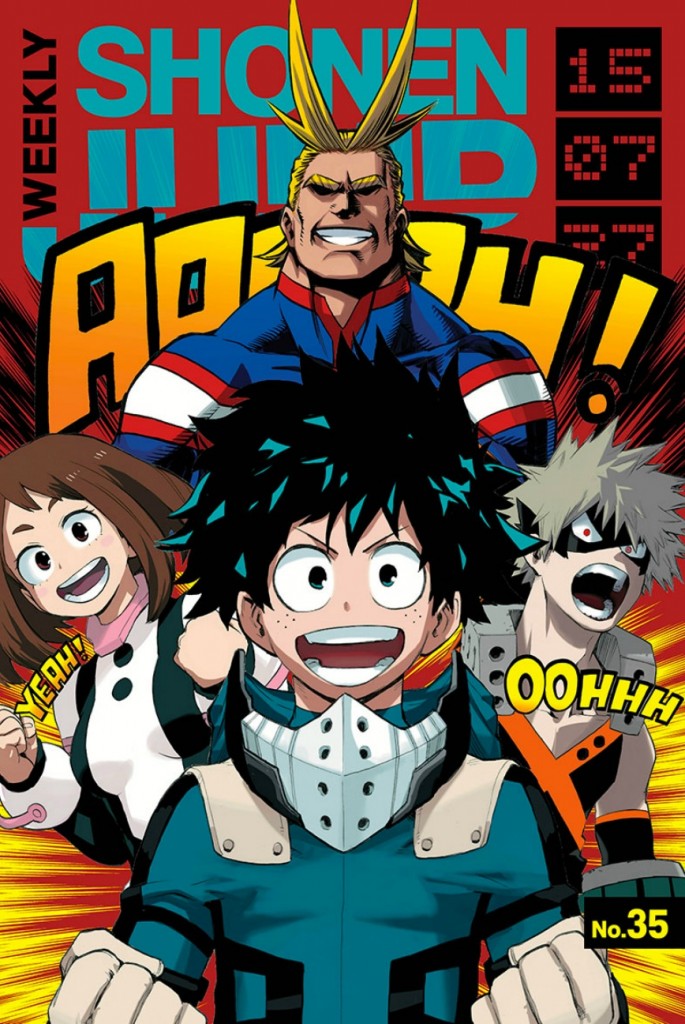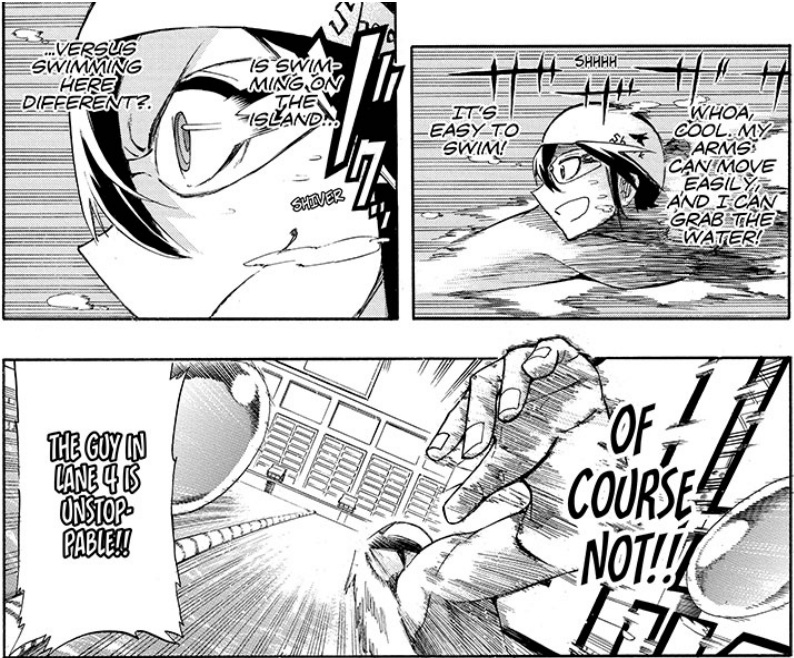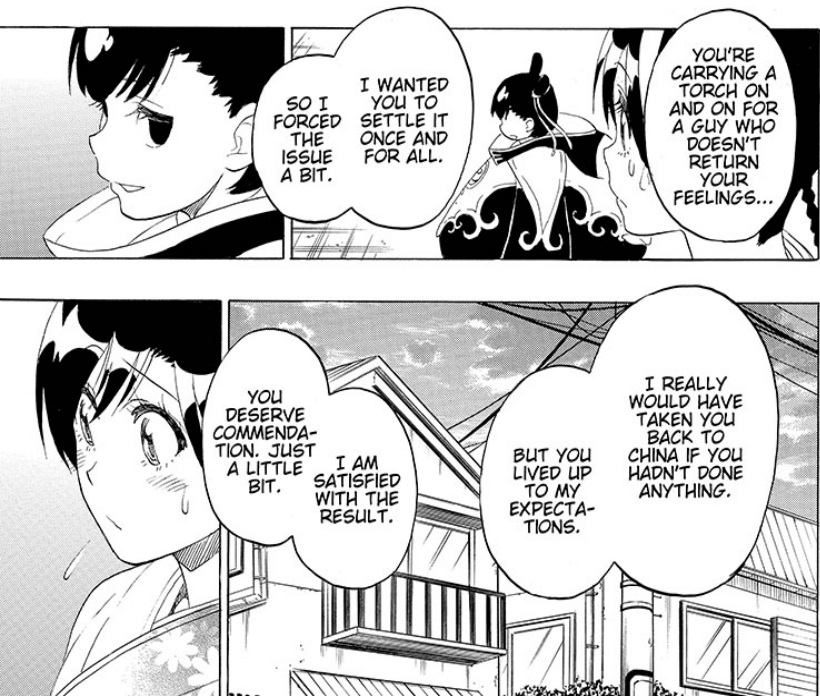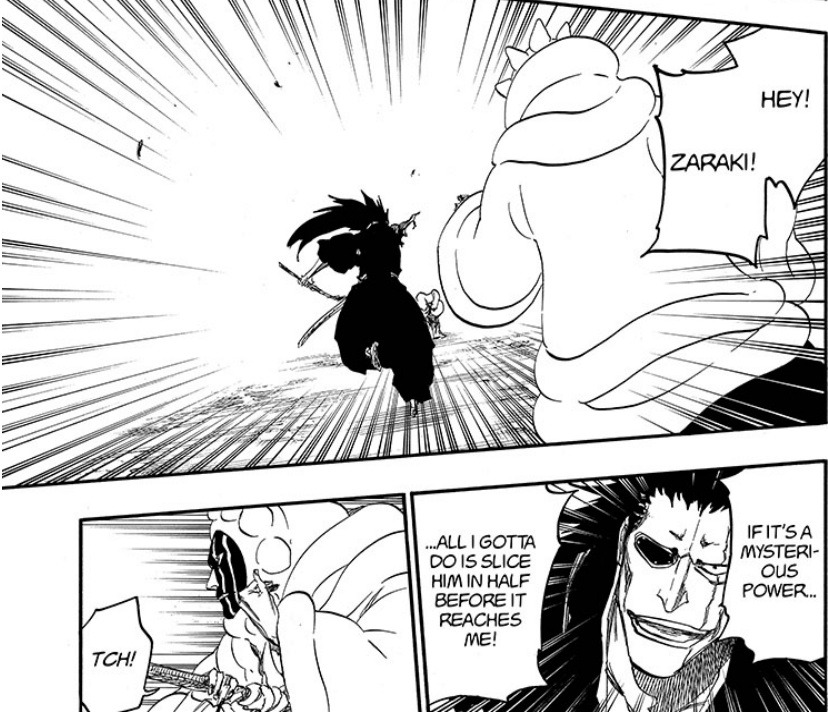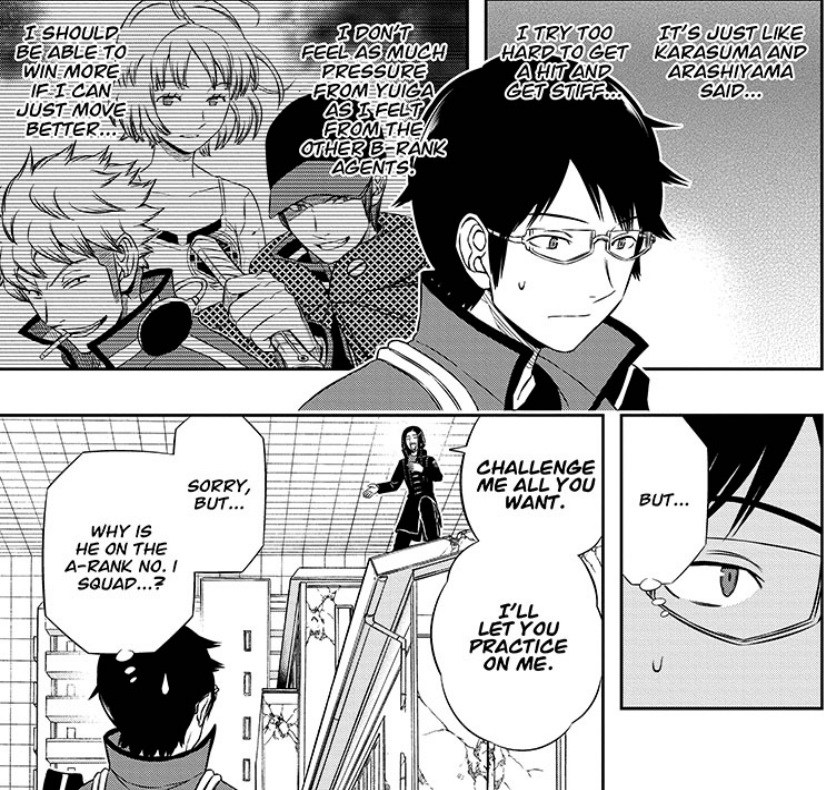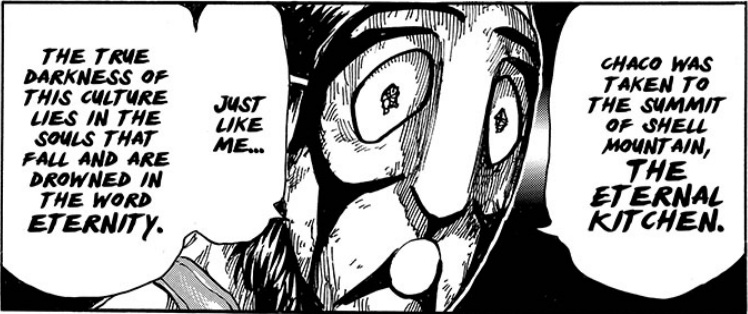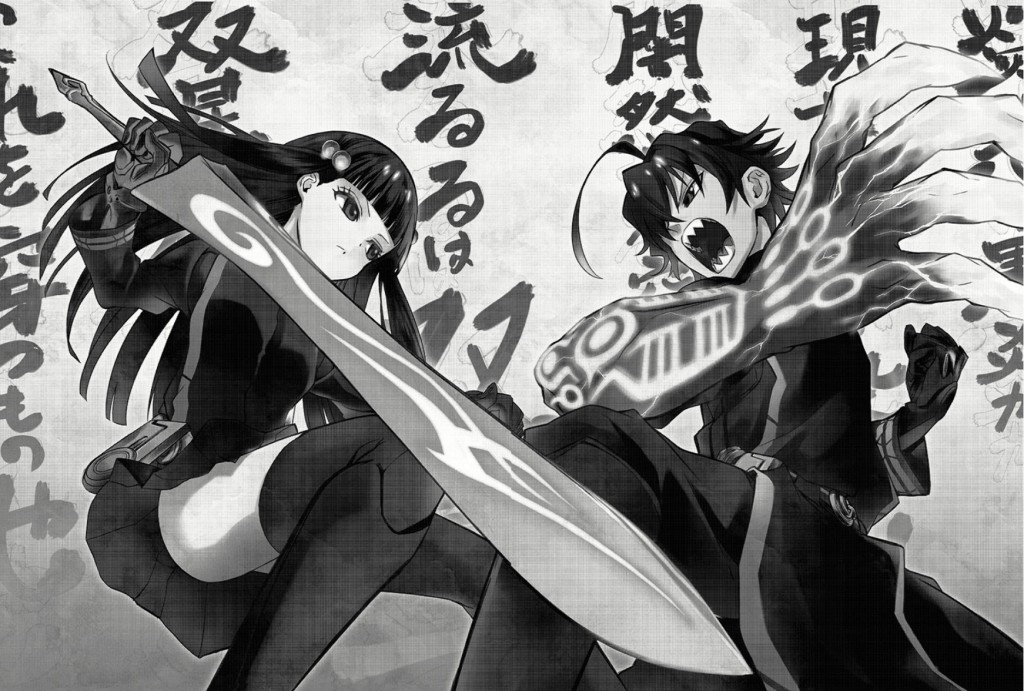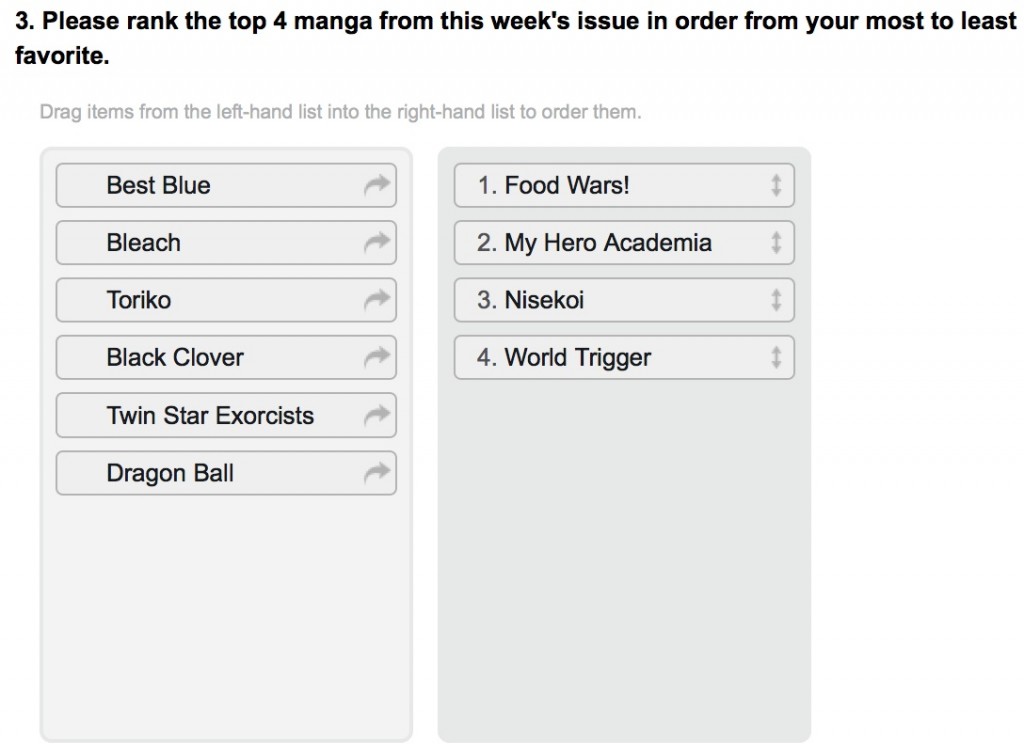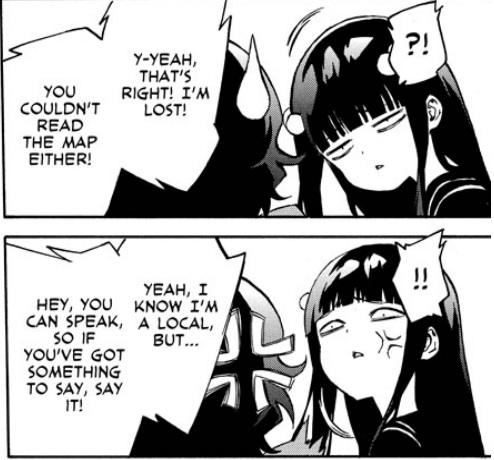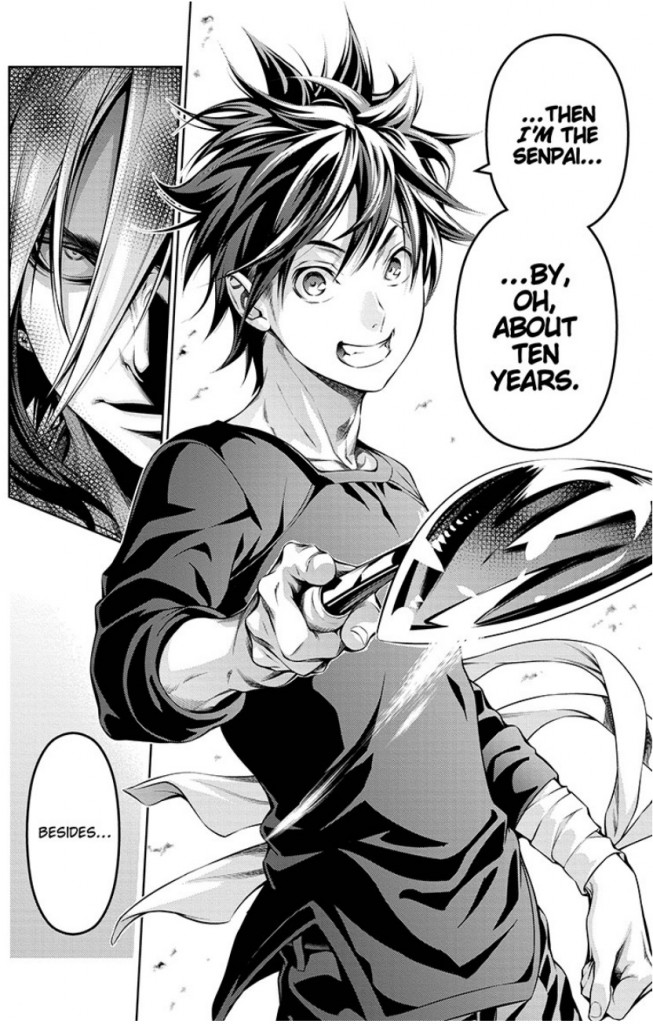07.31
Can I just say that I was so bummed that we didn’t get a Assassination Classroom or Straighten Up! announcement at the end of the issue? With both a Jump Start and Jump Back ending in this issue, it would have been the perfect time to debut a new series in the next. Assassination Classroom has become one of Viz’s most successful manga in sales this year, and next week’s chapter is the 150th; it would have been the perfect time to add it into the lineup. As for Straighten Up!, the rankings have shown it’s pretty popular and will probably stay for the long haul. I know it’s not a very action-y series, but it feels like a waste to not capitalize on a promising new debut that they’ve already given a trial run. From the tone of this week’s Shonen Jump podcast, it doesn’t seem like there’s any plans to add Best Blue in in the foreseeable future either. I’ll be very disappointed if it proves to be another hit in the rankings and they still don’t decide to run it, especially since so many people have been hoping that it would be the vanguard for more sports series being run in the english Jump.
As a side-note, the presence of Twin Star Exorcists in this issue reminds me I still need to catch up on Blue Exorcist and Seraph of the End so I can properly review them for this series. They’ll be back in the issue after next, so I have a lot to read…and I’m not looking forward to that, honestly. But hey, I’m the one who wants these to be thorough full-issue reviews, so I’ll make good on that. I really hope we don’t get more monthlies added in, though. With the exception of Blood Blockade Battlefront (which Viz didn’t license), most of Jump Square’s popular output that I’ve seen is really mediocre and far below the quality level that WSJ has had these days. I might have to shank someone if they decide to add in D. Gray-man into Jump, now that it’s back and all. But maybe their disastrous experience running Hunter X Hunter last year has made them wary to run an erratically published series again.
Well, enough postulating, we’ve got manga to review! In this week of Jump, Bulma flashes an old man, Mayuri gets on everyone’s nerves, and Tamakoma squad celebrate what are probably the most depressing birthday AND the most unromantic Valentine’s Day ever, both in a row! All this and more, After the Jump!
Weekly Shonen Jump: 2015, Issue No. 35
My Hero Academia chapter #52 – “Hero Killer Stain vs. U.A. Students”
Midoriya is truly cut out for the hero business. He has great deductive skills with a keen eye for detail, makes quick rational judgements about the best course of action, sets up contingency plans in case things don’t turn out the way he wants, and above all else, has a lot of heart and determination to help people in need. His one weakness as a hero is his inability to control his power well without hurting himself, but he makes up for that with good judgement as to when and how he should use for the best effect. He makes up for his lack of power with his way of using it. Essentially, he encapsulates what Stain’s ideal of a hero should be.
And you can tell that Stain was incredibly happy about that. Seriously, he gave such a creepy, elated grin after Midoriya declared he would help Ida whether he wanted it or not, and when he saw Midoriya in action in their brief fight. This was the kind of hero he wants more of; honest, selfless, and determined. Not out for glory or personal gain, but someone who fights for the sake of those in need. Which is exactly why he decides to spare him after he wins the fight. He might not be the strongest hero, but he proved he wasn’t just talk, but the real deal. He’s not someone masquerading as a hero; he genuinely IS one.
That difference in attitude in why Stain respects Midoriya but no qualms trying to kill Ida. Midoriya is thinking about rescuing both him and the other injured hero; not defeating Stain or avenging Ida, just saving his life. When Ida confronted Stain, it wasn’t to help the other hero that was being attacked by him, but to get revenge for his brother. Even now, Ida is focused on getting revenge, telling Midoriya that he shouldn’t interfere because “this has nothing to do with [him].” Ida has made this encounter with Stain something personal, and in doing that, has strayed from what his objective as a hero should be. Ida wants to defeat Stain to satisfy his own frustrations that the man he looked up to the most was crippled; he doesn’t care so much that Stain is dangerous and hurting other people so much as he’s angry that he hurt someone close to him. He doesn’t want bring Stain to justice so much as he wants to punish him for hurting someone he knows personally. That isn’t heroism, but vigilantism. He’s ignoring the rules of the law and his priorities as a hero in engaging Stain for his own personal agenda. Through this mindset, he ignored the needs of the people around him and the innocent people he should be protecting. And in this chapter he’s so intoxicated by his desire and his pride that he refuses help from his friend, even though there’s absolutely no way he can win on his own in this situation. Ida is a well-meaning person, but his recent decisions have been beyond selfish, in contrast to Midoriya’s effortless selflessness. That is not what makes a hero, and that is why, despite both him and Midoriya being generally good people, Stain has marked him unworthy of his hero status.
Todoroki’s arrival at the end of the chapter was surprising, but only because I forgot that he was working under Endeavor. The latter’s appearance in the last chapter was clever foreshadowing that Todoroki would also get involved with this situation. It also makes more sense for him to arrive to Midoriya’s aid than Endeavor; the latter is vain and out to oust All Might from his no. 1 hero status, after all. Given that he strong-armed a woman to marry him just because he liked her powers and wanted to breed a strong successor, I wouldn’t put it past him to embrace a chance to sabotage his rival’s protege. But Todoroki is Midoriya’s friend, and given his power and proximity to their location, it should’ve been obvious that he’d be the most likely person he’d ask to give him some back-up.
Todoroki’s arrival throws an interesting swerve in all this, not just in terms of turning the tide of the fight, but also in how Stain will react to him and the message Ida will take from this experience. Todoroki’s goals as a hero were originally selfish as well; he wanted to outdo his father by never using the power of fire he inherited from him, and just use the ice powers he inherited from his mother. The tournament shook him up and made him reconsider if that was really the right thing to do or not, and also made him realize in order to better understand what kind of hero he wants to be, he needed to reconnect with his mother and come to a better understanding of who he is and who he wants to be. When he attacks Stain in this chapter, he uses both of his powers, together. So I take that to mean that he has matured and embraced both sides of himself; the rebellious goal he once had, the desire to become a hero in a way that would spite his father, has been reconsidered. Todoroki may no longer be thinking of being a hero for the sake of getting revenge on his his father, but rather, because he genuinely wants to be one. Which presents a pretty close parallel to Ida’s current situation, as his desire to be a hero is currently motivated more by getting revenge on behalf of a family member than by altruism and passion for the job. How his encounter with Stain will go down, and how Stain will interpret his actions and character, will be quite interesting in to what extent it’ll confirm the growth of Todoroki as both a hero and a person, and his example may serve to help Ida realize he needs to change his mindset before his desire for revenge leads him down a self-destructive path, one that would surely not make his brother proud.
Before we move on, you might be wondering who I voted for in the character poll. I was debating between Stain and Todoroki, as I find both extremely well-crafted and realized. While Stain has been a fascinating character to analyze and see in action these last couple weeks, my vote ultimately went to Todoroki, whose character arc felt the most ambitious and well-developed out of all the main protagonists so far, and whose presence, back-story, and emotional growth really made the latter stretch of the Sports Festival arc for me. Out of all the main characters, his story is the one I’ve gotten the most invested in and interested in seeing develop and grow, which is why I’m ecstatic to see him make a return, and hopefully learn about what went down between him and his mother, and what his goals and convictions are from here on out.
Remember to vote for your favorite MHA character in this week’s survey while you still can! The english Jump doesn’t do these very often, so it’s a treat when an opportunity like this comes around. I’ll be curious to see how the results will differ between the english and japanese polls.
Best Blue chapter #3 – “Tournament”
It makes sense to show that how Aono has improved thanks to his training by having him be victorious in his first competitive swimming race. Especially one that’s just a “for-fun” tournament, and isn’t anything too major to make him out to be overly successful. While he does beat a national-level athlete in this chapter, the hilariously vain “Master” Onaga, this is an all-levels event and he’s the only competitor who was that skilled. We haven’t been introduced to the rest of who Aono’s teammates in the competitive swimming club will be, and the standard skill level for members in that club. Though he’s at the national level, it’s implied that Onaga is a bit of a fool and probably not one of the best swimmers among his group. As such, Aono’s victory doesn’t go too far to make him out to be overly prodigious, but still highly skilled and on par with other nationally-ranked high school swimmers, making it a triumphant moment for the character without blowing the series’ load in terms of power-relativity too quickly.
Beyond showing how Aono has improved and his relative speed and skill level to other swimmers, this chapter also gives him with two potential rivals. One is the aforementioned Onagai, who seems to be sort of a gag antagonist for the moment. The other is the more enigmatic Oshiro, whose relationship with Kagura indicates he’s probably a big deal and a great swimmer. Of course, Oshiro may be a rival for Kagura rather than Aono, but whatever the case it’s clear that the character’s role will be competitive and important going forward. This chapter ultimately serves as a confidence builder for Aono, as he can now see how much he’s improved and stacks up to others his age, and builds the character up so when he encounters his next big roadblock, we can grasp how much harder he’d have to work to get even better from his current level. If I have any complaint about how that’s shown, it’s that the art doesn’t quite sell it. The big panel that shows Aono’s push is a bit confusing to understand at first, and the smaller panels that show how much faster Aono is than everybody else aren’t grand enough to drive the point home and give enough sense of the speed and scale of the event. The chapter really should have devoted a few more pages to the actual race than it did to the character introductions and character-building.
Still, I quite liked all that character-building, and the fact there were a lot of great humorous moments sprinkled into the chapter made it a positively infectious and enjoyable read, that I managed to like even better each time I’ve re-read it. The series really does have a good foundation and good characters going for it, and with just a bit more oomph and excitement added to the swimming scenes, it’ll make for a really excellent and refreshing new entry in the shonen sports genre. Which is why I would really like to read more of it in the english Jump, and why I hope that people have been ranking it in the weekly surveys in strong numbers these past few weeks. The english Jump hasn’t regularly run a sports manga in over two years, and it’s about time that finally changed.
Nisekoi chapter #179 – “Order”
And what do you know, this chapter confirms exactly what I talked about last week! Sure, Yui is not going to be moving away or getting engaged to someone new (just yet), but the point is she’s moving on with her life. She got up the courage to threaten her relationships with her friends and family by admitting her feelings to Raku, she got rejected, she’s accepted that rejection, and now life moves on. She made clear what she wants her relationship with Raku to be now that everything’s in the open, and has decided to support him when he figures out who exactly he likes. She’s talked things over with Chitoge, offering her advice, and in the process has actually deepened their friendship. She reunited and reconnected with old friends, and is pursuing a new social life. She’s found a new place to live, and plans to find someone new when she’s ready. She hasn’t disappeared from the story or the characters’ lives completely, but her role and relationships with them has changed. More importantly, she is also no longer confined and defined by her relationship with that circle of characters. Her conversation with Night in the end of the chapter says it all; she has taken control of the direction she will lead her life in. She has become a fully-realized person who plans to move forward with her life. She has become truly independent. She is now truly an adult.
The ramifications of her decision has affected other characters. From seeing Yui’s example in be honest with her feelings, Raku realizes that he too must make more an effort to understand his and make a decision about them quickly. He feels especially obligated to do it for Marika’s sake; knowing that she truly loves him, but also knowing that he doesn’t love her in the same way, and he owes it to her to be upfront and tell her that. And since she’s no longer a rival but still a mentor, Chitoge can rely on Yui as a confidant to help talk about issues she can’t share with her other friends and Raku, as well as someone to give her advice in pursuing a relationship with Raku. In a way, Yui’ll be for Chitoge what Miyamoto is for Onodera, except not as aggressive in manipulating situations to get them together.
This was a story arc directly about getting the courage to challenge the status quo. Yui’s reservations about telling Raku about her feelings were driven by fears that doing so will negatively affect her relationships and friendships with the other characters. She didn’t want to change because she, essentially, didn’t want to risk giving up a good thing – a consistent, comfortable life with the people she loved. But one’s life does not and should not stay the same forever. People change. People grow up. People grow apart. And Yui , clinging to a love for someone who she was scared wouldn’t feel the same way, would not be able to move on with her life if she didn’t confess to Raku. And after she did, contrary to what she had thought, it wasn’t the end of everything. Raku still wanted to be a brother to her. Chitoge still wanted to be a friend to her. Instead of destroying relationships, she renewed them, and made them even stronger. And in expanding her life past Raku and the circle of people around him, she opened up new possibilities for her social and personal lives. She didn’t lose the connections she had; she replaced them with new ones. Having let go of her childhood, she’s finally ready to enter a new stage in her life and see where it takes her. Now it’s time for the other characters in the series to follow her example. And judging by the effect Yui’s confession has had in conjunction with previous developments, I’m pretty confident they will.
Bleach chapter #636 – “Sensitive Monster”
I share Mayuri’s frustration. Seriously, he might be fight-crazy, but Kenpachi should know better than to blindly attack an enemy whose power he doesn’t understand head-on. He’s played it smart in a fight before – his battle with Tosen, anyone? But no, he acts like an idiot and loses an arm. As if losing an arm means anything in Bleach. Kenpachi usually just fights with one arm anyway so it’s not that big a deal as it is. But then he goes and slashes at the quincy again, and wouldn’t you know it, his entire body starts twisting and convulsing around itself just like his arm did! Anyone with common sense would’ve seen that coming. But of course, Bleach characters don’t have common sense. Except for Mayuri. The mass-murdering sadistic mad scientist whose responsible for horrible atrocities and genocide of the quincies. The unarguably most evil “protagonist” in Bleach is the only one with brains enough to not blindly attack something he doesn’t understand.
Though, that’s only because being Mayuri, he already understands everything. Mayuri is hax. He is the king of asspulls and easy victories and his fights are always about seeing what horrible thing he’ll do to his opponent rather than a tense life-or-death situation where we care about his survival. Just by looking at him, Mayuri has already perfectly deduced his enemies’ power and found a way to inflict terrible pain on him and kill him. And he does it all by himself. Seriously, they should just have Mayuri fight Ywach. Forget Ichigo and Aizen, he’s clearly the most powerful character in this entire series.
This chapter played out exactly how I expected to based on last week. Mayuri easily gets the upper hand on his opponent, and Kenpachi is shafted after losing stupidly and being made to look like a complete idiot. What was the point of building up Kenpachi to be an important asset to the Soul Society when he keeps getting his ass handed to him by dumb gimmicky villains despite his power-up? He became exhausted by fighting fucking Gremmy and then got curbstomped by the female Quincy quartet, and now he lost so bad to this new villain whose name I don’t know at all because he made the stupidest mistake he possibly could. Once again, this is a running example of how Kubo utterly wastes his characters and his build-up and the character arcs he makes for them are absolutely pointless. Kenpachi hasn’t learned anything from his experiences, and it’s not reflected in his battle-strength either. I would appreciate it if he at least got to fight someone that was discernibly strong in a non-abstract way (unlike his last two opponents) so that we get a legitimate pay-off to the whole Kenpachi subplot, but I think we all know that that’s far too much to expect from Kubo at this point. Instead, I see Mayuri cleaning up whatshisname next chapter and the series moving on to another uninteresting battle, but hey, at least this fight was still leagues better than the one with Gremmy.
World Trigger chapter #110 – “Haruaki Azuma”
Wow, I was completely off the mark about Yuiga. He really is just a mediocre agent who happens to be in the best team. The reason why? Nepotism! Well, Border is a military organization after all; I’m not surprised that there’s a case like this. And the way they handled it, Yuiga was put in the best team purposefully. The rest of the members are so skilled in what they do that his weaknesses don’t hinder them too much and he’s consistently reminded and humbled by the fact he’s so outclassed. As stated, he might be an A-Class, but just in name-only. When push comes to shove, his inadequacies will be exposed and endanger him on the battlefield, and he’ll either be forced to improve himself or accept a demotion.
Still, despite being a joke compared to the rest of Tachikawa squad, Yuiga is still a more skilled fighter than Osamu. The point Izumi was trying to make in having Osamu try and best him 100 times in a fight was to show him he’s not yet on the level to master composite shots. However, by training with someone only slightly above his level, Osamu was able to learn how to get more hits of off his opponents, and become more experienced pulling it off. His improvement is reflected in how, at the start of his matches with Yuiga, his record was one in five wins, and by the end, it had increased to one in four. That’s a five percent increase in efficiency, and in a close battle of attrition, being five percent more accurate counts for a lot. He might’ve had the most unromantic Valentine’s Day ever, but with the experience he’s gained fighting against Yuiga, Osamu is in a much stronger position to help his team than he was before.
Speaking of occasions, Chika had to have one of the most depressing and uneventful birthdays I’ve ever seen. No party, no cake, hell, nobody even knew or remembered it until Chika just casually mentioned it to her teammates. And instead of being a happy occasion, it was a stressful and melancholy one because Chika was depressed about exposing the fact she can’t shoot people to their next opponents, and team having to have a serious discussion of what their strategy should be to make up for that, taking extra precaution to keep her hidden. Poor Chika. Like Yuma says, though, it’d be interesting if she’s able to throw their opponents for a loop by overcoming her fear of shooting people and striking back when they come after her, but it remains to be seen if her preparatory training has helped with that.
This next match will definitely come down to the respective teams endurance and strategic prowess. Azuma squad took this into account in selecting the cityscape stage; they know that they don’t have the range for a firefight, so they chose a location that would limit their enemies abilities to best utilize their weapons. Their goal is to take down each of their enemies in two-on-one close quarters fights. Tamakoma squad’s problem going into this match is that they are highly reliant on Yuma to score points, while Osamu and Chika provide back up. Now, each member of the team will need to be able to hold their own without their teammates’ help. Considering they were preparing for a teamwork-based fight, this throws a serious wrench in Tamakoma’s strategy, and with the large and complicated scale of the battlefield and the unusual winter-themed weather conditions, they are now at a huge disadvantage right from the start. Yuma might be able to hold his own against most people, but taking on Kagegura, Ninomiya, and Azuma by himself might be too much for him. With Osamu’s recent training, he should be better equipped to hold his own against multiple opponents, but his inexperience with fighting directly and lack of endurance will inevitably cause him to make risky mistakes. Chika is the one most threatened by facing an opponent on her own due to her inability to shoot people, and the only way she’ll be able to survive this match is if she finally overcomes that phobia. This should prove to be Tamakoma squad’s most desperate and difficult fight yet, and they’ll have to find creative means to not only endure, but win against the three best B-Rank teams in all of Border.
Toriko chapter #332 – “Chaco’s Situation!!”
For the devious air they were presented with in previous chapters, the 10-Shell chefs are humorously goofy and chill. They don’t seem villainous nor do they seem to have anything to hide. There’s no cryptic dialogue or tense conversation or talk of master plans or schemes. These guys just seem like a group of friends hanging out for each other while waiting to participate in a fun competition. If they aren’t a part of the larger conspiracy behind Blue Grill, then it’ll be interesting to see whether they’ll eventually ally with the protagonists to change it. If they are antagonists, though, then their casual attitude makes them pretty refreshing and a lot different compared to enemies faced in Toriko before. If nothing else, it seems like the cooking match between the 10-shell and human world chefs is going to be more a competition of respected peers and two characters you can like and support than an antagonistic confrontation, and that’s something I’m really looking forward to.
While the 10-shell chefs might not have sinister intentions, I’m not sure about Don Slime. Sure, he’s friends with Jiji, but he might be holding secrets from him too. After all, he’s the one whose orchestrated this match between the chefs because he’s interested in their skills. It might not be wrong to assume he wants to see what they are capable of for a reason, and that reason might prove to be exploitative of our heroes. And with the discussion the 10-shell chefs had about how one soul is worth the same as another no matter the age, and the fact Jiji specifically mentions that the Don doesn’t have a body for now, I have a feeling I know what might happen to Chaco’s body after his soul is sold…
Moreover, we learn about what caused the class divide and cruel discrimination in Blue Grill. The residents of Blue Grill are actually all descended from former slaves of the Blue Nitro, who bred them to maximize the best of their gourmet cells. The elite class of Blue Grill are descended from those who have the best gourmet cells, and the lower class is formed by those who weren’t able to perfectly adapt to them and have noticeable defects and disabilities. Because these people aren’t useful for the cooking-focused economy of Blue Grill, they’ve been treated as sub-human, denied human rights, and pretty much enslaved, their souls forcibly taken from their bodies and replaced with superior ones. Those who have their souls replaced are forced into endless labor on “The Project.” We haven’t seen a really dark culture like this in Toriko before, and it’s interesting in terms of seeing both the consequences of the Blue Nitro’s lasting influence on human culture and in potentially presenting a Magnostadt-type of situation where the people in charge of Blue Grill now might now be evil people, but extremely prejudiced. What’s even more interesting to me is how Komatsu is going to rescue Chaco, and exactly who the old man explaining the situation to him really is. There’s a lot of threads going on in this arc; a fun competition on one hand and a darker mystery on the other. How they both manage to complement and tie into each other will be quite interesting to see.
If I have one concern about what’s coming next, it’s that we don’t really know the chefs participating in the match with the 10-shells very well. We only have really seen Nono and Yuda in action before, but the other three have been very minor characters who haven’t had a lot of focus or screen-time, and I honestly can’t remember them too well. I’m still thinking that Chiyo and Chin Chin will come back and join the match, so two of them could be replaced, but while I’m excited to see a cooking competition in Toriko I’m worried that it’s really going to need exceptionally excellent execution if Shimabukuro is going to pull it off with characters we really only barely know.
Food Wars! Shokugeki no Soma chapter #128 – “Blindside”
Wow, Kuga is such an asshole! The way he tells Soma to just pack up his under-selling cart and scram with that shit-eating grin on his face is just such a swarmy, mean-spirited thing to do. I love Kuga’s personality. He’s always so upbeat and peepy about everything he says, even in his beat-downs and jeers. If a normal antagonist were to say the things he does in most other series, I would have dismissed him as one-dimensional stock bully. But the way Kuga goes about doing things, how he says things, and the way he behaves normally just adds a lot of depth and fun to the character and his interactions with Soma. He’s often hilarious, and enjoyable in his mean-spiritedness, whereas with lesser characterization he’d have just been obnoxious.
Week after week we’ve seen Kuga always have the upper hand over Soma and constantly rubbing it in his face. And it’s because of all of this build-up, all of the tension and suspense as to whether Soma can outsell Kuga and wipe that damn smug smirk off of his face, that makes this chapter so, so unbelievably satisfying. Doubly so because the way Soma does it completely plays to his strengths, but in a way that totally surprises and surpasses our expectations. Soma’s always been about taking a dish and going one step further with it by using his inventiveness and creativity. He loves to experiment with food, and the results are dishes that no one else could possibly think of. Yet, at the same time, he’s not self-indulgent with his creations. He caters them to his customers’ tastes and their needs. In the past few days, Soma has gotten valuable feedback about what his customers want and what they would like to see more of. He’s had time to contemplate what the strengths of his cooking is and what the weaknesses of Kuga’s are. Because for as successful as Kuga is, his booth is not completely perfect. Soma’s going to take advantage of what his lacks, and I and guess what a good part of that is. Really, Soma says it himself. Sure, Kuga might know the Culture Festival game better than him and have more connections and resources. Sure, he’s far more experienced in sichuan cooking. However, Soma is more experienced in running an actual food business and dealing first-hand with real customers. As far as running a real restaurant goes, he’s ten years Kuga’s better.
The look on Kuga’s face when he says that is just amazing. In the ten chapters we’ve known him, we have not seen him frown even once. But here he gives the most serious, furious glare you can possibly imagine. It is the most angry and the most solemn we’ve ever seen a character in this series be, especially in response to Soma’s witty remarks. As well he should, as Soma hasn’t merely just dissed Kuga; he’s thrown all the insults he threw right back at him with a thousand times the gall and the balls. And he did it with a smile. Aw. Snap. We’ve never known Soma to hold a grudge, but boy howdy, how cathartic that remark must’ve been for him. It’s a sure sign of his confidence that his dish truly has what it takes to crush Kuga’s lead, and I can’t wait to see him make Kuga eat his words and knock him down a peg more.
Black Clover chapter #23 – “The Distinguished Service Ceremony”
I expected these nobles to all be rude and disdainful of Asta and Yuno because of their poor upbringing. I was expecting that the series would pick out one of these guys to be like “hey, come off it, be chill to these peeps brah,” but I guess they are all just kind of stuck-up rich folks. Which while cliche is one of those more true-to-life cliches so you can’t really fault the series for that. My biggest complaint is really I’m not sure which of these characters are the most important to keep an eye on. We get introduced to all of them in a lengthy description of who they are, their rank, and hints about their powers and personalities in a couple page sequence at the beginning of the chapter, but that doesn’t tell much about how important they’ll be relative to each other. I’m guessing by his screentime in this chapter and his rank in the Golden Dawn that Alecdora will be Asta and Yuno’s most important rival of this bunch, and I’m sure Noelle will have her chance to show up her awful, mean family down the line, but the rest of these guys? I’m not sure how they are going to fit in to the overall narrative as of yet.
But while I don’t know what to make of all these new characters I do really like the core of this chapter. I like how Asta doesn’t care one bit about what the elite knights think of him and just decides to enjoy himself. But then he overhears Alecdora talk smack about Yuno and he stops eating and just stares at him. Then, when Mimosa and Klaus try to stand up for their friends, and end up being chastised and made fun as a consequence, he shows a worried from of concern. And then, when all three of Noelle’s siblings gang up on her in a continuous beat-down, calling her an embarrassment, a disgrace, and a failure for just taking pride in who she is and the one accomplishment she’s had, Asta becomes increasingly more and more furious, and when they finally hurt Noelle so much that she tries to run away from the party, crying, he can’t take it anymore and angrily calls them out as the vain assholes they really are, showing them up by easily dispelling Alecdora’s sand magic, and telling them that they won’t silence him, and no matter what they might say now, he’ll shut them when he becomes the Wizard King.
This is the kind of rush of resolve you can only get in a shonen manga. The way the scene just builds up the irritation and anger of Asta until he lashes out is insanely effective in selling each moment in what is honestly not that novel a moment on the surface. We’ve seen scenes where the underdog hero yells his resolve at people who look down at him before. But part of what makes it work here is that Asta reacts not in response to what people are saying about him, but what people are saying about his friends. It’s a basic trait for a shonen hero to care about his friends, but the extent and passion Asta shows in defending them is genuinely endearing, and gives a great aura of cool to the moment where he dispels Alecdora’s technique and makes them pay attention and listen to what he’s saying. It’s the kind of “fuck yeah” moment of awesome that make manga like this as fun as they are, and is a more interesting way to make Asta a character you really want to see succeed. And while I still feel there needs to be a little more to his character, Asta has been a character I’m becoming increasingly more invested in, and one I’m starting to really care about, and chapters like this help a lot. I’m rooting for Asta just like I’m rooting for this series; I want both to be successful, to pile up merit and prove their worth. This series still needs a bit more work to set it apart from other series in it’s genre, but the heart of a great series is here, and that’s good enough to keep my blood rushing for the moment.
Twin Star Exorcists chapter #1 – “Rokuro and Benio”
I was not expecting them to run a special preview chapter in this issue, so this was quite a surprise. Though maybe not a surprise I found welcome; at least, not at first. I admit that I’ve developed a bit of disinterest in supernatural monster-fighting battle manga over the years. Ever since Bleach became big it seems to have become a prevalent sub-genre with many popular entries, but I’ve seen very few that were particularly appealing to me, or I thought of as any good, really. And with a name like Twin Star Exorcists, I was half-expecting this series to be some kind of spin-off of Blue Exorcist, which I don’t really care for, so I had a bit of an unfair bias against this from the start. That said, this is not related to Blue Exorcist in any way or form beyond the fact that they are both about, well, exorcists. This series has a different approach and a different focus it’s going for, and there’s a whole slew of things that I actually found both good and not so good about this first installment.
Since the series is focused on fighting demons (well, “kegare” as the series calls them, but they’re basically the same thing), it’s a good thing it’s able to sell the horror and danger of the creatures very well. The exorcism scene that begins the chapter does well to characterize the pain and fear that goes into them and the designs of the Kegare themselves are fittingly sinister and creepy-looking. Both lead characters are basic but have enjoyable personalities. The male lead, Rokuro, feels like a normal kid rather than a carboard shonen protagonist, and he has some good bits of dialogue and his quirks, including spontaneously changing what his goal in life is and his overly emotional reactions to things, coming across as more endearing than obnoxious. The female lead, Benio, is actually a lot of fun. She has a quiet, stoic character, but often expresses her emotions in these really exaggerated faces that I found really amusing. She’s a bit stand-offish and rude, but has a recognizably immature and child-like side to her just like Rokuro, which makes them good contrasts as well as compliments to one another.
The one thing they both have in common is sharing a tragic angsty backstory – the same tragic angsty backstory, as it turns out – involving their entire exorcism dorm getting massacred by Kegare when they were young. The interesting about this is not the backstory itself but how it’s affected their personalities and outlook on exorcism as a career, and how different they are. Rokuro came out of the experience wanting to escape from the pain and horrors he saw by living a normal life, shunning that world despite the skill he had for it. But Benio became hardened by the experience, and she resolved to never let that kind of tragedy ever happen again, pursuing a dream of destroying all of the Kegare. It’s an interesting depiction of how two people who underwent the same experience might take a different meaning from it and how that influences their lives and who they are as people. Of course, Rokuro ultimately decides to tap into his exorcism powers and save Benio towards the end of the chapter, but he still has a different outlook on his powers. He sees them as a curse; a binding obligation to fight the Kegare, at the cost of living the comfortable, normal life that he’d rather have. Benio, on the other hand, thinks of such power as a blessing, and the means to do a greater good for the benefit of other people. As a fighting manga, the series is successfully intense and cool-looking with it’s action scenes, but I think it’s real strength as shown in this chapter lies in this conflict of ideologies about the value of their career and purpose of their lives shared by the two leads, and the friction they’ll have coping with these different outlooks and conflicting personalities while working together.
How these two end up rubbing off on one another and how their relationship grows is the big drawing point of this manga more than anything else it has to offer, and it’s because of how interesting their dynamic is that’s going to make me come back to this series and try to catch up to it down the line. Hmm, perhaps I’m not as “meh” about this debut than I had thought? Well, there are a lot of basic “edgy” shonen tropes and plot elements in this chapter that I wasn’t big on, particularly the grim backstory. I don’t find the side-characters very interesting or amusing. In fact, they are kind of distracting and I hope their role is downplayed in the future. The action is effective and well-drawn but not remarkable or anything all that special. Again, it’s Rokuro and Benio who make this debut chapter as strong as it is. They have an interesting dynamic, enjoyable personalities, and are characters I want to see develop as partners and teammates. They have more interesting characterization and stories to make me care about them miles more than I ever could about those of their Jump Square contemporaries Seraph of the End and Blue Exorcist, and I gotta give it props for that. So yeah, I’d have to call this debut chapter successful. It made me interested in a manga from a sub-genre I’ve long been burned out on, and really got me invested in it’s lead characters enough to make me want to see what happens to them next. I didn’t love it, but it got my attention. I’m interested in checking out more. Who knows? With the right execution, this might prove to be the best monster-fighting shonen to come out in a long, long time.
Dragon Ball chapter #4 – “They Call Him…the Turtle Hermit!”
So we’ve come to the end of Dragon Ball‘s Jump Back run. A good stopping point too, ending right after the introduction of Roshi and Goku receiving his iconic flying cloud, Kinto’un, as well as another one of the series’ most infamous early out-there scenes. As I said before, it was really clever of Toriyama to have the “no balls” scene come back as a consequential part of the story, helping Bulma’s procure another dragon ball, though at a “cost” she didn’t quite realize in the moment. It’s just a funny running subplot to have pay off over the course of three chapters the way it did. Content-wise though, it is a bit of an objectionable scene in the fact that Master Roshi, an old man, is getting a nosebleed from viewing the private parts of a teenage girl after he solicits her to show him her panties. This is something that probably wasn’t a big deal for japanese readers, but would cause parents over here to flip out and never let their kids touch the series again if this was a mainstream children’s comic. I’m actually surprised with how popular DB is that no one’s raised a stink about content like this in early DB in the States before, outside of a few library bannings and whatnot. But beyond that, just as far as how we see perceive the characters, Bulma’s willingness to show her panties combined with the scene from the first chapter where she was willing to let Goku cop a feel sorta presents her as a little loose with her sexuality, and Master Roshi comes across as, well, a sexual predator. Now, I am a 100% sure that Toriyama didn’t consider or intend these connotations when he wrote this chapter. This is just how things are in gag manga; it’s fiction, meant for laughs, and harmless fun. And it takes a certain skill for someone to make these scenes still feel like harmless fun for readers from other cultures without most people feeling uncomfortable about them on their first read. That speaks of how both the tone of early DB works in it’s favor, and how good Toriyama is with characterization and comedic timing to land these jokes and make us like these characters.
Onto the subject of Master Roshi, last week I said that I wasn’t sure if Toriyama intended him to have as big a role as he did later on, and this chapter lends a lot of credence to the theory he didn’t. Of note is that there is not a single indication in this chapter that he is a wise and skilled martial artist, despite it being one of the defining characteristics of the character outside of his pervertedness in the pre-Z days. What’s more, his interactions with Goku and Bulma seem purposefully episodic; he was just a weird guy they happened to randomly meet on their travels who happened to have a dragon ball and a magic cloud. He served his role in the story, and then he was gone. And that fits into the spontaneous adventure vibe early DB was going for. The very next chapter saw Goku fight a shape-shifting pig, after all. The scene with Master Roshi might’ve been some reference to Journey to the West or some other bit of Toriyama randomness. If that’s the case, the fact that Toriyama was able to take what was supposed to be a one-off gag character and make him into a fully realized member of the supporting cast is pretty extraordinary, especially since he takes uses all the aspects of Roshi’s personality and character introduced here, such as his connections to mystic artifacts, and simply expands on them to flesh out his history and persona. Also of note is the indication that Roshi’s lived as long as he has because he’s been granted immortality by a phoenix, which is a good explanation as any as to how he’s lived over 300 years.
The Kinto’un scenes are another good bit of character building. The fact that Goku is the only one fit to ride it gives us a good indicator of his moral compass. Not so much that he’s a completely righteous person; after all, it’s not like the cloud is screening out only bad people. The cloud allows only the most pure of heart to ride. Goku, as established before, is naive and untainted by either strong ethical or unethical thoughts. Rather, he is a decidedly neutral creature who does what he does because he wants to, not strictly at the expense or benefit of others. In essence, Goku is pure of heart because he’s not motivated by thoughts that can be categorized as either good or evil, but simply his own. It’s another layer to Goku’s character, adding credence to the notion that he isn’t a hero because he actively tries to do good for good’s sake, but because helping people is something he just instinctively and casually does.
If nothing else, re-reading and analyzing these early chapters have shown a lot of interesting metatextual and contextual interpretations of the characters, world, and success of the series. Everything that makes these characters great, this world great, and makes Dragon Ball great is laid forward from the very beginning and the series only becomes richer and deeper with every subsequent chapter. There is a reason that Dragon Ball continues to be one of anime/manga’s most popular and enduring series. There is an effortless, flawless quality to it. It feels fully realized from the start, even though you and I both know that Toriyama made this shit up as he went along. Simply put, Dragon Ball has a kind of magic, irresistible quality to it that makes it hard for almost anyone who properly reads the series to not find something to like about it. Note that I say read, not watch. While iconic in it’s own right, the anime adaptions of the manga just don’t capture the kinetic quality that pervades Toriyama’s epic from panel to panel, page to page, chapter to chapter, beginning to end. It’s lightning-in-a-bottle. There have been many series that have been inspired by Dragon Ball and have tried to surpass it, but that’s a battle they can’t win. Because no one can manufacture something like Dragon Ball. It’s a product of it’s creator, it’s influences, it’s audience, and it’s time. Reading these chapters again from a critical lends just confirms that for me. The only one who can write and draw Dragon Ball is Akira Toriyama. And on that note, re-visiting the series these last few weeks have made me even more pumped to go see The Resurrection of ‘F’ next week! I’ve been waiting the whole summer for it, and since Toriyama wrote the story himself, I’m fully confident that it’ll be a good time and a worthy continuation of Dragon Ball‘s never-ending story.
With Dragon Ball‘s Jump Back run done, I have to speculate on what they’ll choose next. It’d be cool if they pick Dr. Slump as the follow-up, tying into the Toriyama manga bundles they’ve been selling these last few weeks. It so overlooked and unappreciated compared to DB that it could always use more exposure. Plus, it’d personally be a heck of a lot of fun for me to write about, even though it’s gag-manga nature might make it a bit more challenging to pick apart.
Final Thoughts:
This was about as good a week as last, if not a bit better. I found a lot to enjoy about pretty much every chapter with the obvious exception of Bleach. Twin Star Exorcists didn’t blow my socks off, but it was surprisingly more interesting than I has expected. Outside of Food Wars!, I didn’t get the same amount of excitement out of these chapters as I would have in a truly great week; they were really good, but not quite great. Still, it was a strong output. If there was an underlying theme between all these chapters, it was probably surprising expectations. Soma’s new pasta/mappo tofu fusion dish, Todoroki’s big damn heroes moment, Yui not actually getting engaged, Aono placing first in his first swimming competition, Tamakoma being put in a environment they didn’t prepare for, Asta denouncing the elite knights…you get the idea. There was at least one unexpected aspect or moment to just about every chapter in this issue. And they were fun surprises, which made for some fun reads. It’s nice when you don’t really know what to expect from a series, and can enjoy the fact that no matter how much you speculate you won’t be able to predict exactly how things will turn out. It keeps things interesting, and it’s stuff like this that keeps me coming back to all of these series.
Best Manga of the Week:
1. Food Wars! –Both MHA and Food Wars! were really strong this issue, so it choosing which I’d rank first gave me a bit of pause. Ultimately, I felt that Food Wars! offered a meatier and more fulfilling outing with a great combination of story and character development alongside it’s trademark humor. But what really clinched it’s #1 spot for me was the page where Soma disses Kuga. Everything about that page; Soma’s pose and confident smile, to Kuga’s hyper-realistic scowl, made it an effin’ sweet moment of awesome and elicited a physical “fuck yeah” reaction out of me the first time I read it. It’s been a while since it’s been #1 since other series have been super great lately, but FW! finally wins the spot again this week, and if next week’s chapter is just as strong, will probably be in the top spot next time as well.
2. My Hero Academia – This was a really action-heavy chapter, but it was a really cool one. Midoriya showed the progress he’s made in harnessing One-For-All and applied his trademark strategic wit to go toe to toe with Stain in a surprisingly successful effort. He was ultimately subdued because of Stain’s quirk, but he succeeded in what he set out to do; buy time until reinforcement arrive. And the arrival of Todoroki promises that his efforts will be justly rewarded. With great action and chock full of cool thematic concepts and implications about characters and their development, MHA continues it’s recent hot streak of A-grade chapters.
3. Nisekoi – Not as emotionally powerful as recent chapters, but still featuring exceptionally potent character development and full of genuinely touching scenes and moments. With the status-quo slowly and surely breaking at the seams, Nisekoi really impressed me with this arc and I can’t wait to see where Komi takes the story next.
4. World Trigger – Now, before you say anything, I have been putting Best Blue as 4th when I’ve submitted the actual surveys these past three weeks. I’ve been supporting the effort to get in a new sports manga in Jump. But these reviews don’t necessarily feature the original order of how I ranked them on the survey, and besides, my opinions often change the more I think about the chapters. Ultimately, while I thought Best Blue had a good outing and I ranked it on the survey, I really did like this week’s World Trigger better. It was a really interesting chapter to think about in terms of how Tamakoma’s strategy and Azuma’s strategy’s conflict, the growth each member of Tamakoma squad needed to adapt to their next match, and other small bits of character development and downtime. It was a strong lead-up chapter for the final match of the Rank Wars, and it got me really excited at the possibilities and difficulties facing Tamakoma in it. And with how great the match against Nasu and Suzunari squad was, I more than hyped to see what WT has in store with this one.
Line(s) of the Week:
Bulma: “Hey, why does a ‘Turtle Hermit’ have a magic cloud? I mean, where’s the logic?”
Master Roshi: “Deal with it.”
– Dragon Ball
Panel(s) of the Week:
Page(s) of the Week:
And that’s that for this issue! So until next time, meet some new people, try some new food, and don’t show your undies to any strange old men, and I’ll see you again after the jump!
